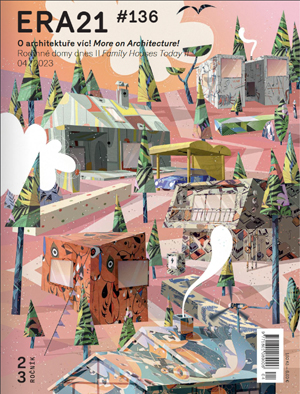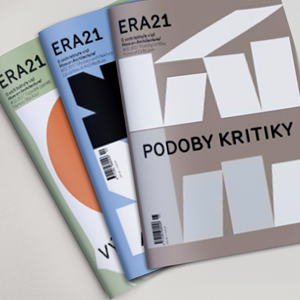| editorial |
Laboratories of Style, Places of Encounter » Back in the 1920s, architect Leopold Bauer described the department store as the cornerstone of public life—a space where culture, fashion, and education converged. His vision went on to inspire numerous department store projects. In recent decades, however, many of these buildings have suffered neglect, marginalization, and, subsequently, a functional and material decline—marked by vacancies, disorder, and in some cases, demolition. |
|
| news | » entire article | |
| completed project |
Mountains and Monastery. Krkonoše Museum in Vrchlabí » The Krkonoše Museum in Vrchlabí was founded in 1883 by the Austrian Krkonoše Association and has been housed in a former Augustinian monastery since 1966. Ecclesiastical architecture does not lend itself well to contemporary museum exhibitions. The recent renovation therefore required a highly sensitive approach—one that would preserve the monastery’s architectural and historical value, while carving out space for a contemporary retelling of the story of the mountains. To accommodate a lecture hall, museum shop, elevator, and visitor facilities, a new concrete entrance structure was added—its form evoking a rugged rock formation. The entire visitor route has been reorganized, too. The cloister garth plays a unique role, both in the exhibition and in the monastery’s architecture, symbolizing the Earth’s connection to the Universe and its spiritual essence. |
|
| intro |
24/7 » In recent years, all across society, we’ve seen turbulent changes in people’s habits. Five years ago, these changes were further strengthened and sped up by the COVID-19 pandemic. A huge increase in e-commerce was one of the results, and with it came major transformations of related processes like transport, storage, and generally the way in which any purchased product reaches the consumer. Mushrooming everywhere around towns and cities, parcel lockers have gradually become an important phenomenon affecting the urban built environment. So far, the state’s and municipalities’ regulatory response hasn’t kept up with the pace of change, but that doesn’t mean we should give up on systemic solutions altogether. In 2023, a few simple rules were formulated in the Czech Cities Cultivation Cookbook, written by graphic designer Veronika Rút Fullerová and her team. Further measures are being prepared. We must act quickly, for the ubiquitous lockers threaten to overwhelm us, as shown in the accompanying photo collage. |
|
| interview |
The Point Is to Find New Synergies. Ippolito Pestellini Laparelli Interviewed by Monika Jasioková » The department stores’ golden era is definitely gone. Yet there are still ways to keep these structures not only alive, but to imbue them with new relevance. Architect Ippolito Pestellini Laparelli—who previously explored this topic at OMA and now continues to focus on similar projects through his own studio, 2050+—spoke with us about the future of department stores and the possibilities for their transformation. |
|
| interview |
Places for Storytelling. Astin le Clercq Interviewed by Monika Jasioková » As technological development accelerates, it is fundamentally reshaping how we relate to the world around us. Astin le Clercq, co-founder of the Modem office for design and innovation, has long worked at the intersection of physical and digital environments. In an interview with ERA21, he reveals how new technologies can bridge the gap between online shopping and physical stores. |
|
| completed project |
Jewellery Box. Galeries Lafayette Department Store in Paris » On the iconic Champs-Élysées in Paris, a 1930s bank has been reinvented as a retail laboratory for the world's leading fashion, food, and lifestyle brands. The Art Deco building was reopened to the public thanks to the Galeries Lafayette hybrid model. The magnificent architecture of the bank, including original stone floors, columns, and wall cladding, was preserved but reinterpreted in a contemporary way. New glass and steel design elements complement the space, serving as display shelves and fitting rooms. The polished gleam of these new “jewels” highlights the exclusive quality of the displayed items, but more importantly, reflects the spirit of the interwar bank building. |
|
| history |
Consumer Cathedrals at a Crossroads. Modern Department Stores and Their Fate in the Era of Information Technology » When we look around, we see living things, landscapes, and built environments, but almost everything else is things. Clothes, a car, a computer, a phone, a plate, a mug, a table, a suspended ceiling, a lamp or chandelier, a chair or armchair, a floor. All of these objects have been produced by industry—sold by someone, bought by someone else, and incorporated into the world around us. These everyday processes take place in a certain environment, at a certain speed and rhythm. An object’s journey from production to consumer represents a specific part of the rhythm of life; therefore, the topic of department stores also concerns many historical, economic, or social areas. |
|
| completed project |
A Good Neighbor. IKEA Furniture Store and Hostel in Vienna » The Swedish home furnishing brand has opened a new flagship store in a central location on Vienna’s Mariahilfer Straße. The unique building organization brings us one step closer to the future of retail and to viable and ecological cities. Above the furniture store itself there is a hostel and a public roof garden. On the other hand, there is no parking in the building. Public transport is preferred instead, and for bulkier items there are delivery options for customers. Back in 2017, the competition brief stated very clearly the client’s goal—we want to be a good neighbor. The building resembles a shelving unit, allowing interior space to extend outward where necessary, or to add terraces and greenery. Vertical circulation is organized primarily in the spacious central courtyard, encouraging visual connections, and motivating customers to explore the upper floors. |
|
| history and present |
A Neglected Layer of Our Memory » Although in the beginning the socialist regime ideologically opposed the idea of a Western consumer society, it later admitted that, besides industry and housing construction, it was also necessary to focus on retail. Overcoming standardisation guidelines and the limitations of available structural systems, the architects of the new department stores managed to find design solutions that complemented the stores’ locations, often in close proximity to historic town centers. Both the Prior department stores and the simultaneously emerging network of Jednota shops possess indisputable artistic and architectural qualities. They form an integral, albeit often neglected, part of our history and memory. The selected case studies demonstrate a range of possible approaches—from preservation to refurbishment, adaptation, and demolition. |
|
| interview |
How to Create Consumer-Citizens. The Post-War Shopping Center of a Welfare State Janina Gosseye Interviewed by Jana Pavlová » Shopping malls are not just places of consumption; they also mirror social transformations, economic strategies, and political interests. From the post-war reconstruction of European cities to the boom of American suburbs, malls were centers of community life, where commerce intertwined with culture and public space. However, under neoliberalism, they gradually transformed into commercial and entertainment complexes focused primarily on the individualized consumer. What kind of impact has this transformation had on public space and the social dynamics of cities? And what role can shopping malls play now, in the era of digitalization, when retail is increasingly moving online? |
|
| project |
Transforming a Fragment of Urban Identity. Conversations about the Rescue and Refurbishment of the Breda Department Store in Opava » Opava recently set a unique precedent when a bottom-up citizen initiative succeeded in motivating the city to buy the Breda department store, a significant local cultural monument. In conversations with several different actors in this process, we discuss the mechanisms leading to the purchase, the significance of the building in the city’s context, and the formulation of the competition brief that had to balance heritage preservation with a much-needed adaptation for a new program. Finally, together with the winning team we look at the progress they’ve made so far with the refurbishment project. |
|
| idea |
Retail Gesamtkunstwerk » In response to ever-increasing customer demands, luxury fashion brands have begun opening brick-and-mortar stores that could almost be described as “total works of art.” Aiming to attract new audiences and declare their prestige as patrons of culture, they seek a closer connection between haute couture, art, and architecture. While this double-edged trend has the potential to create unique immersive environments and offer artists space to present their work through access to exclusive platforms, the exhibitions often merely conceal commercial motivations and problematic production processes. This phenomenon—aptly referred to as artwashing—raises questions about authenticity, the commodification of art, and the boundaries between ethics, aesthetics, and marketing. |
|
| trends | ||
| annex | ||
| annex | ||
| annex | ||
| annex |


ERA21 vydává ERA Média, s. r. o. |
|
|
Phone: +420 530 500 801 E-mail: redakce@era21.cz |
|
| WEBdesign Kangaroo group, a.s. |